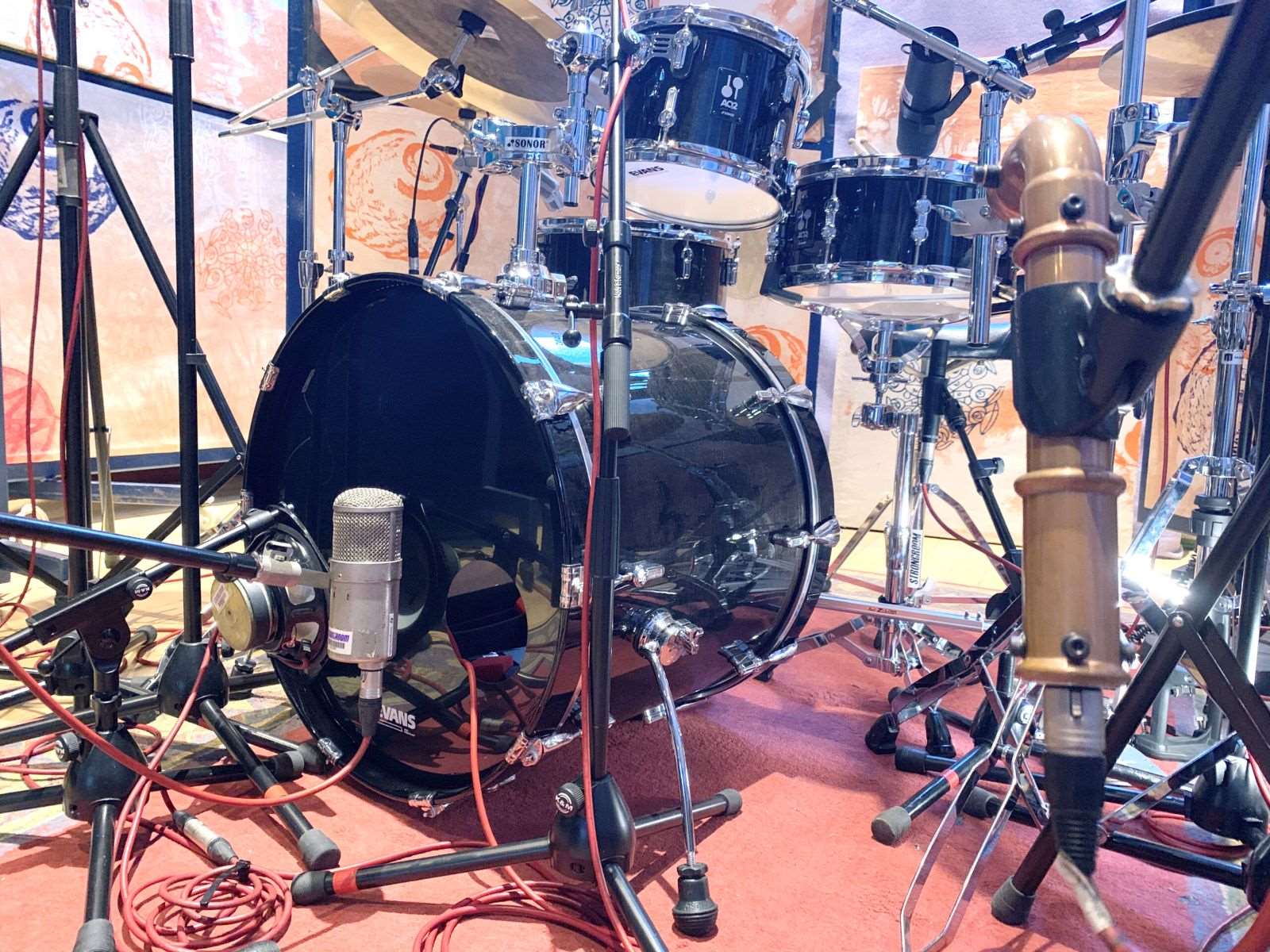Home>Instruments>Bass>How To Play A Bass Drum


Bass
How To Play A Bass Drum
Modified: January 22, 2024
Learn how to play a bass drum with our comprehensive guide. Master the techniques and unleash the powerful sound of the bass drum in your music.
(Many of the links in this article redirect to a specific reviewed product. Your purchase of these products through affiliate links helps to generate commission for AudioLover.com, at no extra cost. Learn more)
Table of Contents
Introduction
The bass drum is an essential component of a drum set, providing the foundation and rhythm for any musical piece. Whether you’re a beginner starting your musical journey or an experienced drummer looking to expand your skills, learning how to play a bass drum will greatly enhance your overall drumming abilities.
Playing the bass drum requires not only proper technique but also an understanding of basic rhythms and coordination. With practice and dedication, you’ll be able to create powerful and grooving beats that will make your audience move.
This comprehensive guide will walk you through the steps to play a bass drum effectively. From setting up your drum set to mastering advanced techniques, you’ll find everything you need to know to become a skilled bass drum player.
Whether you’re interested in playing rock, jazz, funk, or any other genre, the techniques and principles covered in this guide will provide you with a solid foundation.
So, let’s dive in and learn how to play the bass drum like a pro!
Step 1: Proper Bass Drum Setup
Before you start playing the bass drum, it’s crucial to ensure that it is properly set up for optimal performance. Here are the key steps to follow:
- Positioning: Place the bass drum in front of you, slightly tilted towards you at a comfortable angle. It should be low enough so that your foot can comfortably reach the pedal, but high enough so that the beater strikes the center of the drum head.
- Pedal Adjustment: Adjust the beater angle and height to your preference. The beater angle determines the impact and sound of the drum, while the height determines the force and rebound. Experiment with different settings to find what works best for you.
- Tension: Ensure that the bass drum head is properly tensioned. Use a drum key to tighten or loosen the tension rods evenly around the drum head. A balanced tension will result in a consistent and controlled sound.
- Dampening: Depending on the desired sound, you may want to add dampening to the bass drum. This can be achieved by using a blanket or pillows inside the drum, or by using specialized dampening pads or gels. Experiment with different amounts of dampening to achieve your preferred sound.
- Footboard Angle: Adjust the footboard angle of the pedal to match your playing style. Some drummers prefer a flat footboard for a powerful stroke, while others prefer a slightly angled footboard for faster and more controlled playing.
- Pedal Spring Tension: Adjust the spring tension of the pedal according to your foot’s strength and playing style. Higher tension will provide a faster response, while lower tension will offer more control and finesse.
By taking the time to properly set up your bass drum, you’ll ensure that it is comfortable to play and that it produces the desired sound. Remember to experiment with different settings and make adjustments as needed to find what works best for you.
Step 2: Foot Technique and Positioning
Mastering proper foot technique and positioning is essential for playing the bass drum effectively. Here are some key tips to help you develop a solid foundation:
- Foot Placement: Position your foot on the bass drum pedal, keeping your heel slightly raised and your toes resting on the footboard. This allows for better control and leverage when striking the drum.
- Toe or Heel Technique: Experiment with different techniques to find what works best for you. Some drummers prefer using their toes to strike the drum (toe technique), while others use their heel (heel technique). Both techniques have their own advantages, so find what feels most comfortable and natural for you.
- Synchronization: Coordinate the movement of your foot with your hands. Practice playing simple rhythms with a metronome, ensuring that your foot strikes the drum in perfect synchronization with your drumstick hits. This will help develop your sense of timing and overall coordination.
- Power and Control: Focus on striking the bass drum with enough power to produce the desired sound, but also maintain control to prevent excessive rebound or loss of accuracy. This balance can be achieved through consistent practice and control of your leg muscles.
- Practice Pedal Exercises: Dedicate time to specific exercises that focus on developing your bass drum technique. Start with simple exercises that involve single strokes, gradually increasing the complexity and speed over time. This will help build strength, speed, and accuracy in your foot technique.
- Vary Your Volume: Experiment with different dynamics when playing the bass drum. Practice playing soft and loud strokes, focusing on controlling the volume and intensity of each hit. This will allow you to add dynamics and expressiveness to your playing.
As with any instrument, consistent practice is key to developing proper foot technique and positioning. Take your time and be patient with your progress. With practice and dedication, you’ll be able to execute precise and powerful bass drum strokes with ease.
Step 3: Understanding Basic Rhythms
Developing a solid foundation in rhythm is crucial for playing the bass drum effectively. Understanding basic rhythms will enable you to groove with precision and maintain a steady beat. Here are some key concepts to help you grasp essential rhythms:
- Quarter Notes: The most basic unit of measurement in music is the quarter note. It is typically represented by a solid notehead without any stems or flags. In 4/4 time, each quarter note receives one beat.
- Eighth Notes: Eighth notes are half the duration of a quarter note. They are represented by a notehead with a flag or beam attached. In 4/4 time, two eighth notes are played in the same amount of time as one quarter note.
- Rests: Rests indicate periods of silence in music. They are equally important as notes, as they contribute to the overall rhythm. Practice counting and playing rests to develop a strong sense of timing.
- Rhythmic Grid: Visualize rhythm as a grid, with each beat represented by a division on the grid. This grid helps you stay organized and accurately place your bass drum strokes to maintain a consistent rhythm.
- Subdivisions: Subdivisions refer to dividing beats into smaller units. For example, in 4/4 time, each beat can be divided into four sixteenth notes or two eighth notes. Practice playing different subdivisions to improve your rhythmic accuracy.
- Syncopation: Syncopation occurs when accents or emphasis are placed on weak beats or off-beats. It adds a sense of groove and unpredictability to the rhythm. Experiment with incorporating syncopated bass drum strokes to enhance your playing.
Take the time to practice playing various rhythms using the bass drum. Start with simple exercises using quarter notes, eighth notes, and rests, gradually building up to more complex patterns. Use a metronome to maintain a steady tempo and ensure your rhythm remains consistent.
By developing a strong foundation in understanding basic rhythms, you’ll be able to confidently play along with different musical genres and maintain a solid groove on the bass drum.
Step 4: Playing Single Strokes
Playing single strokes on the bass drum is a fundamental skill that forms the basis for more complex patterns and techniques. Mastering this technique will allow you to play clean and consistent beats. Here’s how you can practice and improve your single strokes:
- Starting Position: Begin by positioning your foot slightly above the bass drum pedal, with your toes resting on the footboard. This starting position allows for a fluid motion when striking the drum.
- Full Extension: Extend your leg forward from the starting position, using your ankle and leg muscles to generate power. As you reach the peak of the motion, strike the bass drum with your foot, making contact with the beater at the center of the drum head.
- Rebound and Recovery: After striking the drum, allow the beater to rebound off the drum head naturally. Quickly return your foot to the starting position to prepare for the next stroke. Practice maintaining control and minimizing excess movement between strokes.
- Consistent Dynamics: Aim for consistency in volume and power with each stroke. Practice playing the bass drum at various dynamic levels, ensuring that each stroke is controlled and intentional. This will help you develop control over your foot technique.
- Varying Speed and Tempo: Gradually increase the speed of your single strokes, starting at a comfortable tempo and building up over time. Practice playing in different time signatures and grooves to develop your ability to adapt to various musical contexts.
- Practice with a Metronome: Use a metronome to practice playing single strokes in time. Start with a slow tempo and gradually increase the speed as you become more comfortable. This not only helps improve your timing but also trains your foot to stay synchronized with other instruments.
- Combining Single Strokes with Snare Drum: As you become more proficient with single strokes on the bass drum, practice incorporating them with snare drum patterns. This will help develop coordination and synchronization between your hands and feet.
Consistent practice and attention to technique are key to mastering single strokes on the bass drum. Focus on maintaining control, precision, and a steady tempo. As you become more comfortable with single strokes, you’ll be ready to explore more advanced bass drum techniques and patterns.
Step 5: Mastering Double Strokes
Mastering double strokes on the bass drum will allow you to play faster and more intricate rhythms. This technique involves striking the drum twice with the same foot in rapid succession. Here’s how you can practice and improve your double strokes:
- Starting Position: Begin with the same starting position as single strokes, with your foot slightly above the pedal and toes resting on the footboard. This position will give you the necessary leverage for the rapid motion of double strokes.
- Leg and Ankle Motion: Utilize a combination of leg and ankle motion to execute the double strokes. The first stroke comes from the initial motion of the leg, while the second stroke comes from a controlled ankle motion, producing a rapid rebound.
- Weight Control: Distribute the weight between the initial stroke and rebound stroke. The first stroke should be slightly stronger and heavier, while the second stroke should be lighter and controlled. Practice finding the right balance of weight to achieve clean and even double strokes.
- Practice Rudiments: Incorporate double strokes into rudiments such as paradiddles, double stroke rolls, and flam accents. This will not only improve your double stroke technique but also enhance your overall drumming skills and coordination.
- Gradual Speed Increase: Begin practicing double strokes at a comfortable tempo and gradually increase the speed over time. Focus on maintaining control and evenness between the two strokes. Use a metronome to ensure accuracy and precision.
- Controlled Rebound: After each double stroke, allow the beater to rebound off the drum head. Practice controlling the rebound to minimize excess motion and maintain a steady rhythm. This will help with maintaining speed and accuracy.
- Even Dynamics: Aim for consistency in volume and power with your double strokes. Practice playing them at different dynamic levels to develop control and finesse. This will allow you to express a wider range of emotions in your playing.
Consistent practice is essential to mastering double strokes on the bass drum. Start at a slower tempo and gradually increase speed as you become more comfortable. Remember to focus on technique, control, and maintaining a steady rhythm. With time and dedication, you’ll be able to execute clean and lightning-fast double strokes with precision and confidence.
Step 6: Incorporating Triplets and Rolls
Incorporating triplets and rolls into your bass drum playing adds complexity and depth to your rhythms. Triplets divide beats into three equal parts, while rolls involve rapid and continuous strokes. Here’s how you can practice and improve your triplet and roll techniques on the bass drum:
- Understanding Triplets: Familiarize yourself with the concept of triplets and their rhythmic value. In 4/4 time, a triplet fills one beat with three evenly spaced notes. Practice counting and playing triplets to develop a solid understanding of their timing.
- Controlled Stroke Speed: When playing triplets, focus on maintaining a consistent and controlled stroke speed. Start slowly and gradually increase the tempo as you become more comfortable. Use a metronome to ensure accuracy and precision.
- Hand-Foot Coordination: Practice coordinating your hands and feet when incorporating triplets. Start with simple patterns, such as playing triplet accents on the snare drum while maintaining a steady bass drum rhythm. Gradually increase the complexity by adding variations and fills.
- Roll Technique: To execute rolls on the bass drum, use rapid double strokes with each foot. Start slowly and gradually increase the speed, focusing on maintaining control and evenness between the strokes. Practice rolls in different musical contexts to develop your versatility.
- Combining Triplets and Rolls: Experiment with combining triplets and rolls to create interesting and intricate bass drum patterns. Incorporate them into your fills, grooves, and improvisations to add flair and complexity to your playing. Practice transitioning smoothly between different rhythmic elements.
- Dynamic Control: Pay attention to dynamics when playing triplets and rolls. Practice playing them at different dynamic levels to add nuance and expression to your playing. By varying the volume and intensity, you can create a more dynamic and engaging performance.
- Transcription and Study: Listen to and study recordings of drummers who excel at incorporating triplets and rolls on the bass drum. Analyze their technique, rhythmic choices, and musicality. Transcribe their parts and practice playing along to develop your own style.
Consistent practice and experimentation are key to incorporating triplets and rolls into your bass drum playing. Start with simple exercises and gradually increase the complexity as you become more comfortable. Embrace creativity and explore different rhythmic possibilities to develop your unique style and musical voice on the bass drum.
Step 7: Creating Dynamic Accents
Creating dynamic accents on the bass drum adds depth and excitement to your playing, allowing you to emphasize certain beats or sections of a musical piece. By mastering dynamic accents, you can bring variation and expressiveness to your bass drum playing. Here’s how you can practice and improve your skills in creating dynamic accents:
- Understanding Dynamics: Familiarize yourself with the concept of dynamics in music, which refers to the variation in volume and intensity. Dynamics are typically indicated by markings such as pianissimo (pp), piano (p), forte (f), and fortissimo (ff). Practice playing bass drum strokes at different dynamic levels to develop control and awareness.
- Accent Placement: Determine where you want to place accents within a musical phrase or beat. Accents typically fall on strong beats, creating contrast and emphasis. Experiment with different accent placements to find what sounds best for a particular piece or groove.
- Dynamic Control: Focus on controlling the volume and intensity of your bass drum strokes. Practice playing accents louder and with more force, while keeping non-accented strokes softer. This control will allow you to create clear and expressive accents.
- Gradual Dynamic Buildup: Experiment with gradually increasing the volume and intensity leading up to an accent. This creates a sense of anticipation and impact. Practice starting with softer strokes and gradually increasing the force and volume as you approach the accent.
- Contrasting Dynamics: Explore the use of contrasting dynamics within a musical piece. For example, play a section with soft and subtle bass drum strokes, and then transition to a section with powerful and bold accents. This variation adds interest and adds dynamics to your playing.
- Accents in Fill Patterns: Practice incorporating accents into your fill patterns. Experiment with different rhythm placements and accent patterns to create tension and release within the fills. This will add excitement and flair to your drumming performance.
- Listening and Analysis: Listen to drummers who are known for their dynamic playing and pay close attention to their techniques and choices. Analyze their use of accents and try to replicate their style. This will help you broaden your musical vocabulary and develop your own unique approach to creating dynamic accents.
Consistent practice and experimentation are essential to master the art of creating dynamic accents on the bass drum. Develop control over your stroke dynamics and experiment with different accent placements and patterns. By incorporating dynamics, you’ll be able to bring your bass drum playing to life, adding excitement and depth to your musical performance.
Step 8: Playing with a Band or Ensemble
Playing with a band or ensemble is an exciting and crucial step in becoming a well-rounded bass drum player. It involves collaborating with other musicians, staying in sync with the rhythm section, and contributing to the overall sound of the group. Here are some tips to help you navigate playing with a band or ensemble:
- Listening and Communication: Pay close attention to what the other musicians are playing. Listen to their phrasing, dynamics, and overall sound. Effective communication with the band members ensures a cohesive performance.
- Locking In with the Rhythm Section: As a bass drum player, your primary role is to anchor the rhythm section. Establish a strong connection with the bass player and drummer, focusing on playing in sync and maintaining a solid groove. This cohesion forms the foundation for the rest of the band.
- Supporting the Band: Understand the genre and style of music you are playing and adapt your bass drum playing accordingly. Support the band by providing a solid and consistent rhythm, accentuating important musical moments, and complementing the other instruments.
- Following Musical Cues: Pay attention to musical cues from other band members, such as fills, transitions, or changes in dynamics. Being aware of these cues allows for seamless transitions and ensures that you are in sync with the rest of the ensemble.
- Dynamic Sensitivity: Take note of the overall dynamic range of the band and adjust your playing accordingly. Use your bass drum strokes to add impact during climactic moments and dial it back during quieter passages. Being dynamic enhances the overall musical expression.
- Collaborative Creativity: Experiment with different bass drum patterns and fills during rehearsals and performances. Explore how your playing can enhance and contribute to the band’s arrangments. Collaboratively brainstorm ideas to inject creativity and freshness into the music.
- Being a Team Player: Always remember that playing with a band or ensemble is a team effort. Support and encourage your fellow musicians, and be open to constructive feedback. Embrace the opportunity to learn from others and evolve as a musician.
- Adapting to Live Performances: Live performances may present unique challenges such as additional adrenaline, interaction with the audience, and unforeseen surprises. Embrace these experiences and remain adaptable. Prepare by rehearsing with the band and anticipate any potential changes or challenges that may arise.
Playing with a band or ensemble requires not only technical skill but also the ability to collaborate and contribute to the collective musical experience. Embrace the opportunity to grow and learn from your bandmates, and above all, have fun making music together!
Conclusion
Congratulations! You have reached the end of this comprehensive guide on how to play the bass drum. By following the steps outlined in this article, you have learned the essential techniques, rhythms, and dynamics necessary to become a skilled bass drum player.
From setting up your drum set correctly to mastering single and double strokes, incorporating triplets and rolls, and creating dynamic accents, you have developed a solid foundation on which to build your skills. Remember to practice regularly, focusing on precision, control, and a consistent sense of timing.
Playing the bass drum is not just about technical proficiency, but also about creativity and collaboration. As you progress, consider applying your newfound skills within a band or ensemble setting. Listen, communicate, and support your fellow musicians to create a cohesive and captivating musical experience.
Don’t be afraid to experiment and explore your own unique style. Continue to learn from and be inspired by other drummers, analyzing their techniques and incorporating them into your playing. Remember that becoming a skilled bass drum player is a journey that requires patience, dedication, and a passion for making music.
Now, it’s time to go out there and put your knowledge into action. Whether you’re playing in a band, jamming with friends, or simply practicing on your own, enjoy the process and embrace the joy of playing the bass drum. So grab your sticks, set up your drum kit, and let the beats of the bass drum resonate through your music!











